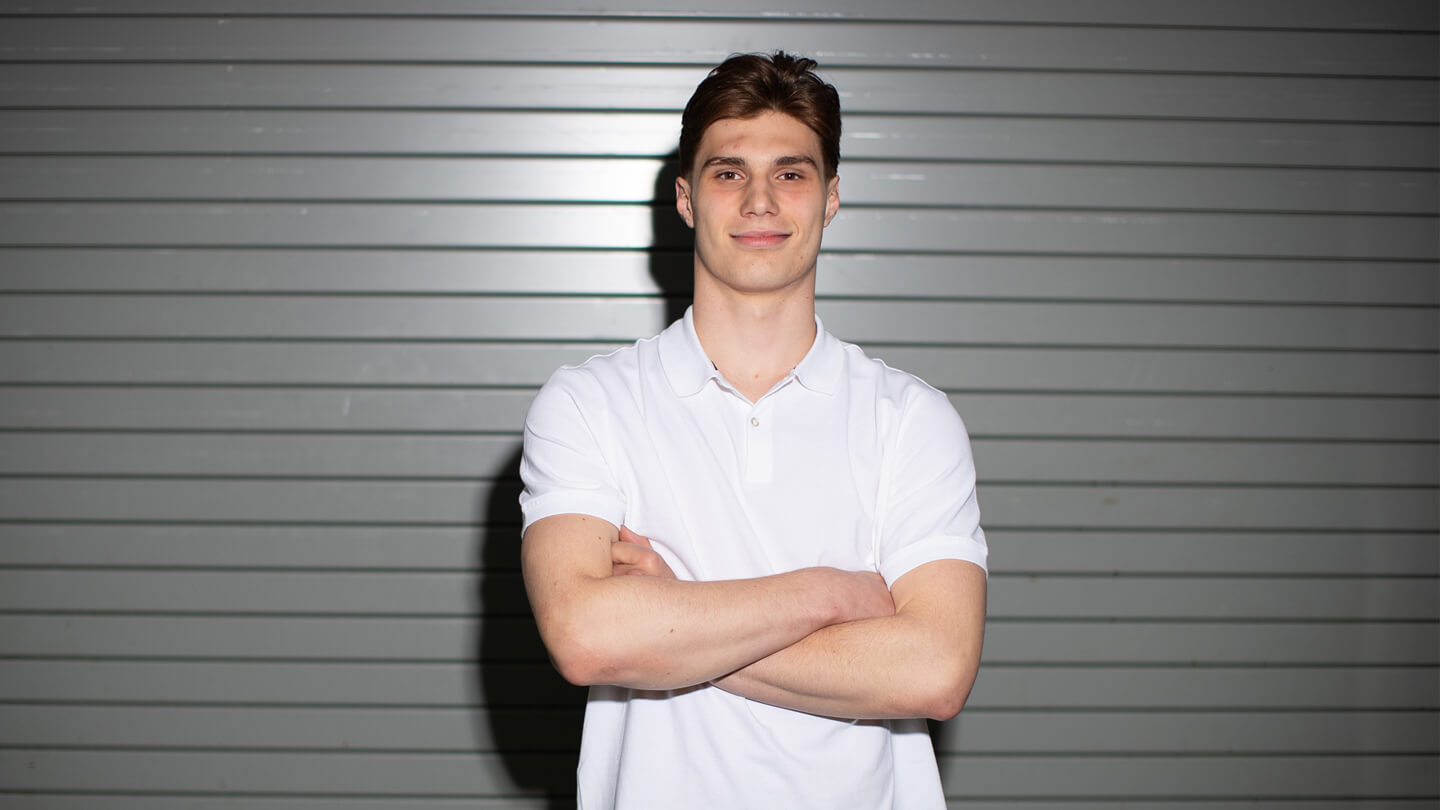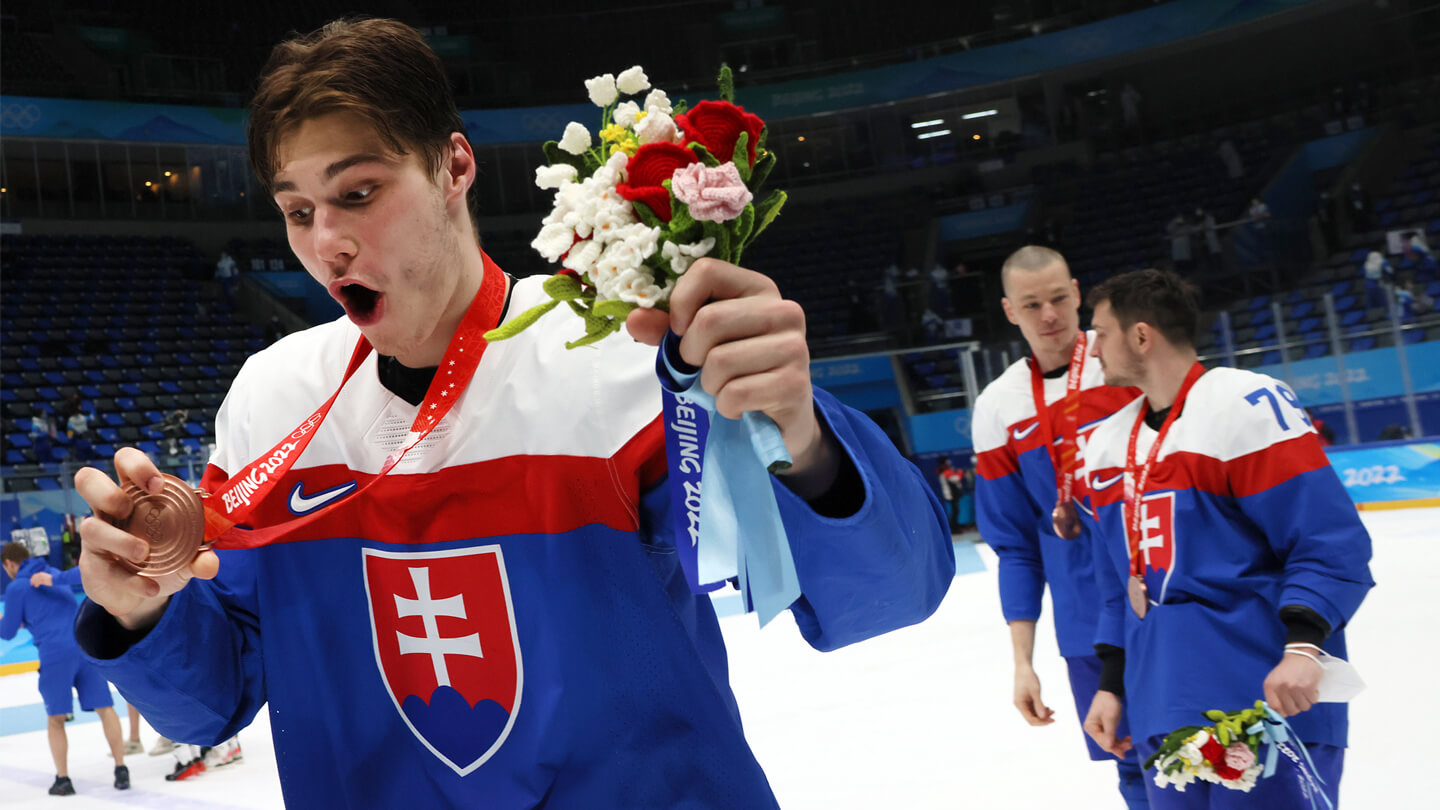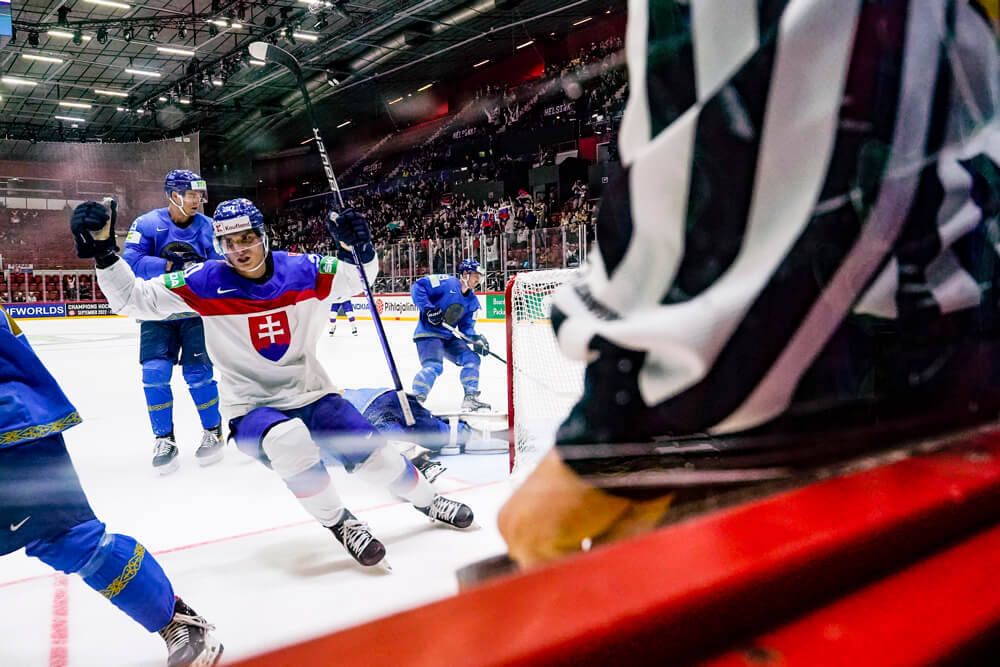
“BUILT TO PLAY HOCKEY”

A
ny player would be fired up to score his team’s first goal at the Olympics, so it was no surprise to hear Juraj Slafkovsky hoot through his full-cage mask and raise a big right arm to the sky when he did just that about five months ago in China. The more you place Slafkovsky’s Games-opening goal from this past February into context, though, the more you understand why the Slovakian might have seemed just a little extra juiced to get it. For starters, Slafkovsky was still about six weeks shy of his 18th birthday when the Beijing Games kicked off — his braces were often visible through the wire cage — and 17-year-olds tend to be a little more excitable than your standard 10-year pro. Also, the goal — one of two he scored in the game — came against Finland, where Slafkovsky has been playing his club hockey since his early teen years. Then there was the plain-and-simple fact that, quite frankly, the big fella needed one. Bad. Though he’d played very solid hockey for the men’s national team at the 2021 World Championship the previous spring, Slafkovsky left the event without a goal. Ditto for the three Olympic qualifiers Slovakia contested in advance of Beijing, where he managed a single assist. He actually entered the Games a heralded 2022 NHL draft prospect playing on a fourth line. But when Slafkovsky outmuscled Hannes Bjorninen in front of Finnish goalie Harri Sateri and chipped a loose puck into the top of the net, it provided the boost even confident players sometimes require to get themselves rolling. “That just gave him a little edge,” says Craig Ramsay, coach of the Slovak squad. “No matter how well you play, every player wants to score a goal. Once he did, then he was a top guy.”
Though the pair of goals Slafkovsky scored wound up coming in a 6-2 loss, they really do seem like the starting point of a pre-NHL Entry Draft rise that might yet culminate with him becoming the top pick in a few days’ time. The live-and-in-person draft will be the first of its kind in three years and, in case you haven’t heard, the host team holds the top selection and the city of Montreal will be breathlessly waiting to hear which name the Canadiens call. At Christmas, the idea of Slafkovsky going No. 1 was unthinkable. Now, after an MVP performance at the Olympics — he led the tournament with seven goals — and an extremely impressive showing at the World Championship in May, he’s in the catbird seat on more than one mock draft and anything seems possible for this charismatic power winger.

O
n the heels of a long season that included the Olympics, a run to the Liiga final in Finland with Turku-based TPS and another couple weeks of intense hockey at the worlds, Slafkovsky took a pass on the physical activities that mark the final day of the NHL Scouting Combine in Buffalo. Really, despite all the ways we can quantify an athlete’s strength and endurance these days, you basically learn everything you need to know about Slafkovsky’s body the moment you lay eyes on him. His answer to the “What animal do you see yourself as?” question teams like to ask was “Wolf.” That’s appropriate because, when Slafkovsky enters a room, you sit up and take notice almost as if an actual Canis lupus had loped in. “If you saw him in a t-shirt and shorts, you would never think he was 18 years old,” says Scott Moser, an assistant coach with the Slovakian entry at the 2022 World Junior Championship that was cut shorty by COVID. “Especially his lower body; it’s almost like he’s built to play hockey.”
At six-foot-four and 218 pounds, Slafkovsky is hard to miss and easy to like. Simon Jellus, who just finished his freshman year at the University of Vermont, played with Slafkovsky on past Slovakian junior national squads and the two have roomed together. Despite the fact Slafkovsky was often two or three years younger than other guys on the teams, Jellus says, you could tell he always felt comfortable in his own skin and never had any trouble speaking up both in social settings and in the dressing room. “You usually don’t see that from a young guy like he was.”
At least in those settings Slafkovsky could use his native language. That wasn’t the case when he left for Finland at 14, feeling like the best way to chase down his NHL dream was to face a higher calibre of competition than he could get at home. “You have a player who left home — new country, new environment — to play the game,” says Dan Marr, the director of NHL Central Scouting. “So right away that tells you the commitment and desire he has.”
Slafkovsky’s father, also named Juraj, told his son at the time that he might as well make the leap because if things didn’t work out for one reason or another, his old bed was always waiting for him. The senior Slafkovsky likely wasn’t surprised when his son made the adjustment, though, because from the junior Juraj’s earliest days, his actions were always guided by a love of the game. “He devoted a lot of effort to hockey all time since he was child,” Juraj wrote in an email. “We never forced him to go trainings, he got up without problems [at 5 or 6 a.m.]”
His attitude and physique play into a notable dynamic with Slafkovsky: While people rave about the left winger, it’s not necessarily his actual goal-scoring abilities they gush about first. Don’t get it twisted, Slafkovsky has some elite offensive tools. Anybody who saw him snipe top shelf on Team USA’s Strauss Mann to open the scoring in the Olympic quarterfinals or jig his way coast-to-coast looking like a jet-fuelled transport truck versus Kazakhstan at the worlds can tell you that. His ability to win battles and protect the puck along the boards would already challenge the most seasoned NHL defenders, and with his long reach and great-for-his-size speed, he can spin out of the corners and create enough space for himself to show off a very good shot. Despite all that, even Slafkovsky himself doesn’t foreground his sniping ability when characterizing his game, instead putting the emphasis on the fact he wants to be a man for all seasons. “I wouldn’t say that I’m, like, a goal-scorer; of course I like to score,” he says. “I want to do best everything, like, in every position, either defending or offensive zone. When it’s a close score and we need to defend, I would love to be playing in every situation.”
Ramsay — who’s seen every type of player imaginable since he first broke into the NHL as a winger with the Buffalo Sabres in the early 1970s — has a very similar view of Slafkovsky’s profile. And even though he doesn’t think of ‘Slavy’ as a born-to-score winger like you’d typically expect to see at the top of the draft, Ramsay draws a line to an extremely productive player he coached when he was on the Philadelphia Flyers bench in the late 1990s. “He reminds me of John LeClair,” says Ramsay, referencing the six-foot-three winger who scored 50 goals three times. “That’s a big comparison at this point, but a big, strong guy who goes to the net and certainly isn’t a natural scorer [but is]willing to pay the price to score a goal. [Slafkovsky is] just committed to getting around the net and doing whatever it takes. He’s willing to battle to score a goal.”
For all the special stuff Ramsay has seen from Slafkovsky on the ice, though, the scene that sticks for him came when the young Slovak was on the bench. It was during the preliminary round at the Olympics, as Slafkovsky was finding his game and taking on more and more responsibility. Ramsay’s side had just successfully killed a penalty and, typically, the coach would follow that up by putting the top unit — which Slafkovsky was now a part of — on the ice. Because Slafkovsky had just been out killing the penalty, though, the coach hesitated for a moment before calling the next trio. “He had just come off, so I was going to wait one shift,” Ramsay says. “I looked over and he was staring at me, nodding his head. He was ready.”

N
ot long after returning from China, Tomas Prokop slipped away for what was likely an overdue haircut. At the time, Slovakia was jubilant following the country’s first-ever Olympic hockey medal and when you’re a senior writer covering all that excitement for a daily newspaper, it’s hard to find time to get a little taken off the top. Everyone was reveling in what happened, so when Prokop’s hairdresser — by her own admission, not a huge hockey fan —said she now knew exactly who Juraj Slafkovsky was, it was in no way surprising.
Twenty years ago, even casual supporters of the frozen game in Slovakia could likely cite a handful of players without much trouble. There was Marian Gaborik, the highest Slovakian ever selected in an NHL draft at third overall in 2000. Zdeno Chara was a Norris Trophy runner-up in 2004 and his Ottawa Senators teammate at the time, Marian Hossa, was one of the best two-way wingers in the game. The path laid by the likes of Peter Stastny in the 1980s — before Czechoslovakia split into two countries — and Peter Bondra and Ziggy Palffy in the ’90s — when Slovakia was its own entity — allowed for a ‘Golden Generation’ to flourish. From 2000 to 2003, Slovakia claimed one medal of every colour at the worlds. In a 2010 Olympic semifinal matchup, they came within a whisper of knocking off the Canadian team that wound up winning gold in Vancouver. A silver medal at the worlds in 2012, though, was a red herring in terms of where the national game was going. “It was so bad,” Prokop says of the decade that followed. “It was a total mess.”
As is usually the case when something really slides off the rails, a confluence of events sent Slovak hockey into the sewer. At the start of the 2010s, a respected international coach — Canadian Glen Hanlon — was hired to run the program, but Prokop says a lot of people weren’t eager to embrace an outsider’s philosophies and Hanlon wound up having a short stay. In the meantime, some club teams in the national league faced financial issues and young players saw fewer and fewer opportunities to grow as the national team defaulted to defensive posture on the ice, relying on veterans to choke the life out of games. It worked in all the wrong ways. While fan support in such a hockey-mad country was never going to fully evaporate, people started to turn away. “Hockey was still popular, but not as popular as it used to be,” Prokop says.
The biggest names, of course, forge their reputation in the world’s best league and, indeed, it’s a pretty bleak NHL scene for the Slovaks right now. Should Chara retire this summer at age 45, that would leave Tomas Tatar — a secondary scorer on the New Jersey Devils — and Erik Cernak — a valued member of the Tampa Bay blue line, but by no means a star — as the most prominent Slovaks in the league. In all, just four Slovaks played 50 games in the NHL this past season; in 2005-06, the first year back after the owners’ lockout, that number was 22.
If a few factors led to Slovakian hockey faltering, there’s no debate the decision to hire Miro Satan as federation president in 2017 was the single thing that set the country back on course. Prokop says Satan — a veteran of over 1,000 NHL games and the captain of the medal-winning national teams at the turn-of-the-century worlds — brought the clout and vision to get things done. It was Satan who tabbed Ramsay — the two were together in Boston near the end of Satan’s playing days — to guide the national team shortly after he was hired. “All I hear about [from people in the Slovak federation]is how much they just love Craig Ramsay and what he’s doing with their men’s program,” says Moser, who will be back as an assistant with Slovakia this summer when the 2022 WJC makeup tournament is held in August.
While Ramsay says he, too, initially experienced some of that resistance Hanlon bumped into, the endorsement of Satan — to say nothing of his own unimpeachable resume — goes a long way and he believes coaches at all levels in the country are on-board with the direction he and his boss would like to push Slovak hockey. “We’ve tried to change the way we play,” Ramsay says. “We want to be fast, we want to be attacking, we don’t want to back up.”

Included within that more forward-thinking approach is a willingness to give real playing time to the next generation. Slafkovsky is the youngest player ever to score a goal for the senior national team, and he was barely a month past his 17th birthday when he played at the worlds in Latvia last May. Defenceman Simon Nemec has basically been beside Slafkovsky every step of the way during the past couple years and he’s a strong candidate to be a top-five selection this week as well. Throw in right winger Filip Mesar and it’s conceivable a country that hasn’t produced a first-rounder since 2005 may suddenly have three in ’22.
The hype train can keep on rumbling into next year, too, as 2005-born Dalibor Dvorsky — who plays the centre position at which Slovaks have long struggled to produce high-end players — already has NHL scouts drooling. “I don’t think it’s a one-off,” Moser says of the Slovak bumper crop. “I think the federation took a deep dive into what it could do to keep improving on its development and I think they’ve done a wonderful job. I’m American, but it didn’t take long to have a ton of pride in Slovak hockey and where it is going.”
For his part, Slafkovsky is certainly a student of the Slovak giants of the past. The NHLer he’s watched most closely the past little while is Finn and new Stanley Cup champion Mikko Rantanen. But, while Rantanen is a natural reference point for who Slafkovsky could become — they both cut their teeth with TPS — it’s more than linking two countrymen to suggest Slafkovsky’s overall game on the flank could stand out the way Hossa’s did during a Hall-of-Fame career. “It feels good when someone says, ‘You look like Marian Hossa,’” Slafkovsky acknowledges. “It’s just good motivation to be, like, at least half as good as he was.”
Prokop refers to Slafkovsky as “a showcase of the fresh start for Slovak hockey,” and the latter is very open about the fact he hopes he and his cohort can inspire a new generation of youngsters in his country to throw themselves into the game. As if he hasn’t done enough this year to get people’s attention, being the No. 1 pick would kick things up yet another notch. “I cannot even imagine that,” Slafkovsky says. “It would be crazy and I would be so happy and I would [think]the hard work I did so far paid off. But of course it would be just the beginning of hockey life in North America.”
Wherever Slafkovsky slots in, it’s easy to figure out what follows. You always have to allow for variance when projecting exactly what kind of pro a teenager will be five years from now, but there are elements of this player — both on and off the ice — that are going to travel well. “People are drawn to him,” Moser says.
Soon enough, we’ll know who gets to be in the inner circle.
Chase Agnello-Dean/NHLI via Getty Images; Mario Hommes/DeFodi Images via Getty Images; Bruce Bennett/Getty Images; Jari Pestelacci/Eurasia Sport Images/Getty Images.




